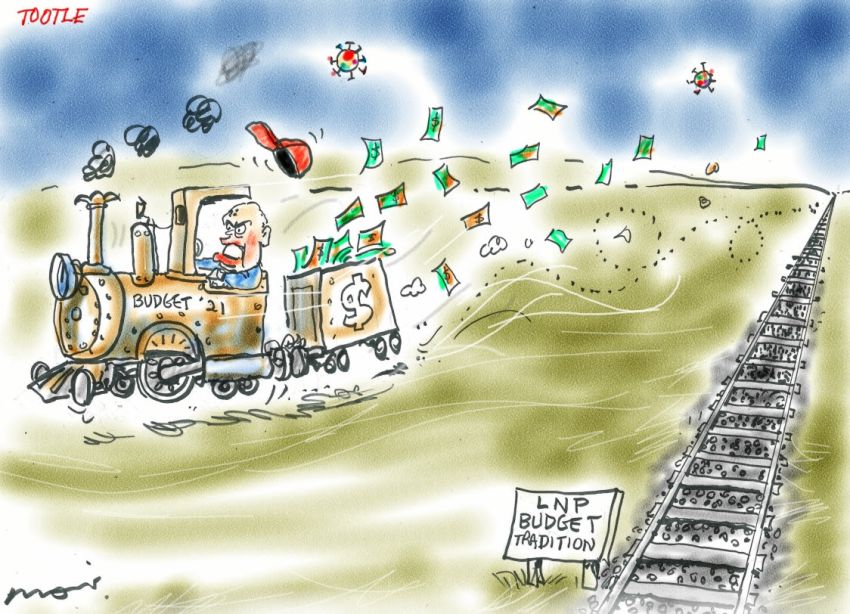
After eliminating almost all of the more generous spending measures introduced to counter the COVID-19 economic crisis, the federal government has indicated it will soft-peddle on further cuts in the May 11 budget.
As Treasurer Josh Frydenberg told the Australian Chamber of Commerce and Industry on April 29: “We won’t be undertaking any sharp pivots towards ‘austerity’.
“For fiscal consolidation to be sustainable, it should rely on gradual changes that are made over time and that provide the foundation for a growing, thriving economy.”
This is a far cry from the government’s howls of “debt and deficit disaster” in response to the then Labor government’s much smaller stimulus spending, following the 2008 global financial crisis.
It is also a departure from the Coalition’s usual commitment to neoliberal economics, although in a context in which neoliberal governments globally have changed their tune, at least temporarily.
Even the recent more moderate language of “budget repair” looks like it will be moved to the back burner.
The motivation for this temporary change in perspective will be, in part, the standard political calculation that this is likely to be the last budget before the next federal election. With the vaccine roll-out falling drastically short of target, the government can ill afford to lose more credibility with voters.
Its inept handling of Brittney Higgin’s rape allegations and subsequent revelations of parliamentary misogyny also damaged its standing: a recent Guardian Essential Poll on April 29 showed its primary vote among women had dropped from 37% against 33% for Labor in mid-January, to 31% against 37% for Labor.
The government’s change in tone also recognises that the recession is far from over and a sudden return to business as usual “fiscal responsibility” will prolong the downturn.
Unemployment fell to 5.6% in March, down from the peak of 7.5% in July, but is still short of the pre-pandemic 5.1% of February last year. The end of the JobKeeper wage subsidy at the end of March is likely to forestall continuing improvement in those figures.
Although annual gross domestic product growth improved from -6.7% to the end of June quarter, it was still -1.1% to the end of December. However, this figure obscures some large disparities between different sectors, with notable sectors like tourism-related industries still well in crisis.
Production for the December quarter was up 20% compared to 2020 in agriculture, forestry and fishing, and 6.3% in retail. But it was down by 13.2% in accommodation and food services, and 16.8% in transport, postal and warehousing.
The stall in the vaccine roll-out means that a return to “normal” functioning, especially for particular pandemic-struck industries, is further off than thought, even leaving aside concerns about international economic recovery or new virus strains.
In its pre-pandemic drive to create its never-delivered budget surplus, the government relied on the Reserve Bank to lower interest rates for economic stimulus. This came up against mild-mannered protestations from the Reserve Bank of Australia (RBA).
With interest rates now at next to zero, there is little more the RBA can do. The ball is entirely in the government’s court to keep the economy from crisis with a budgetary stimulus.
While it might shy away from harsh budget cuts, there is no likelihood that Frydenberg’s budget will be egalitarian, nor that its change in tone will be anything other than temporary.
The bulk of pandemic spending has already been removed: JobKeeper has been ended and JobSeeker has been reduced almost to its dismal pre-pandemic level.
Trumpeting its concern at losing the women’s vote, the Coalition announced a $1.7 billion increase in spending on childcare. Families with more than one child in care will receive a rise in their subsidy.
However, given that this benefit only goes to a quarter of those families using childcare, it is underwhelming especially compared to its fee-free childcare measure during the pandemic.
Another issue slowing austerity measures this time around is that the “We can’t afford it” rhetoric, used to deny improvements in welfare, has lost credibility. The pandemic showed the government can cover hundreds of billions of extra spending if it wants to.
Frydenberg’s pre-budget speech made special mention of NAIRU (non-accelerating inflation rate of unemployment). NAIRU is standard in mainstream neoclassical economics and refers to the “natural” rate of unemployment (often even called “full employment”) below which inflation and wages will start to grow.
Frydenberg suggested that estimates of the correct NAIRU rate have fallen to between 4.5% and 5%, rather than 5%, and that this “lower estimate of the NAIRU means a lower unemployment rate will now be required to see inflation and wages accelerate”.
He added: “In effect, both the RBA and Treasury’s best estimate is that the unemployment rate will now need to have a four in front of it to deliver this outcome.”
This implies that the government is looking to NAIRU as the level at which is can go back to business as usual – free reign to resume its attacks on welfare, and other progressive measures, in the name of “fiscal responsibility”.
Although it is common in mainstream economics, politicians rarely talk about NAIRU. This is because it is not only a benchmark to aim to reduce unemployment to, it is also a benchmark to stop unemployment falling far below.
Mainstream economic wisdom is that any lower unemployment will lead to rising inflation, to increased bargaining power for workers and, hence, higher wages and lower profits.
Frydenberg would have felt comfortable talking about NAIRU in front of the Chamber of Commerce. But it has highlighted the fact that unemployment is a deliberate government policy which, in turn, exposes just how callous its slashing of the JobSeeker rates back to poverty levels really is.